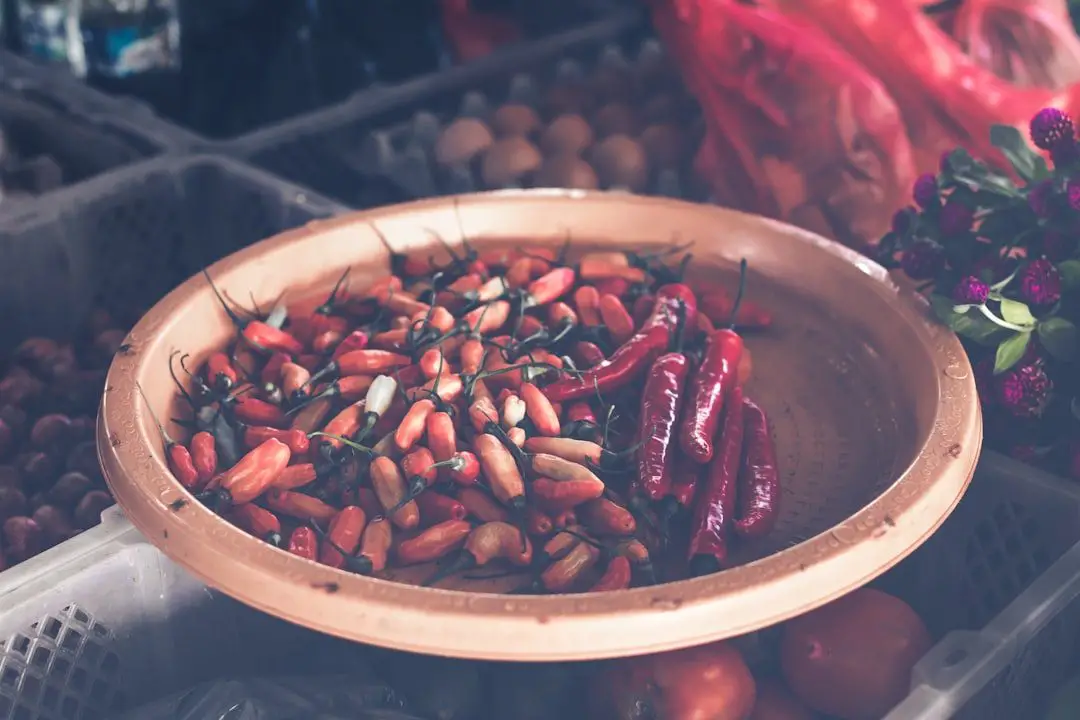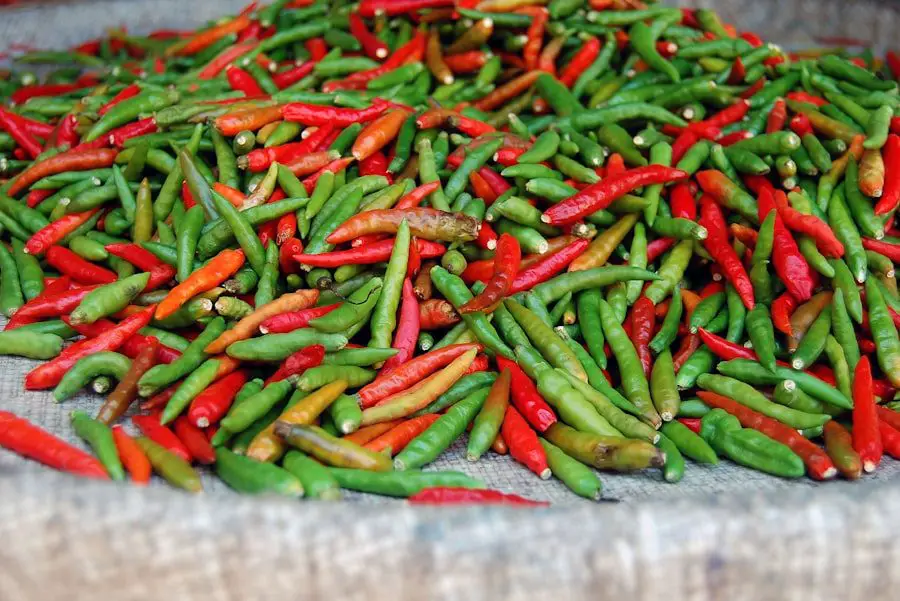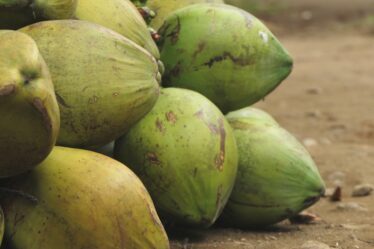
Cascabel Pepper, also known as the “rattle chili,” is a small round chili pepper that originated in Mexico. The name “Cascabel” comes from the Spanish word for “rattle,” which refers to the sound the seeds make when the pepper is shaken. This unique pepper has a long history in Mexican cuisine and holds cultural significance in the region.
The origins of Cascabel Pepper can be traced back to Mexico, where it has been cultivated for centuries. It is believed to have been domesticated by the indigenous people of Mexico, who used it as a staple ingredient in their cooking. The pepper was later introduced to other parts of the world through trade routes and colonization.
In Mexican cuisine, Cascabel Pepper is highly valued for its rich flavor and mild heat. It is often used in traditional dishes such as mole sauces, salsas, and stews. The pepper adds depth and complexity to these dishes, enhancing their overall taste. Cascabel Pepper has become an integral part of Mexican culinary heritage and continues to be cherished by chefs and home cooks alike.
Key Takeaways
- Cascabel pepper is a Mexican chili pepper with a long history and origin dating back to pre-Columbian times.
- The pepper has a unique flavor profile, with a nutty and slightly smoky taste, and a mild to medium heat level.
- Cascabel pepper is a healthy spice, rich in vitamins and minerals, and has anti-inflammatory and antioxidant properties.
- The pepper is versatile in the kitchen, used in a variety of dishes from soups and stews to sauces and marinades.
- When cooking with Cascabel pepper, it’s important to toast and rehydrate the dried peppers before use to bring out their full flavor.
Characteristics and Flavor Profile of Cascabel Pepper
Cascabel Pepper is a small round chili pepper that measures about 1-2 inches in diameter. It has a smooth, shiny skin that ranges in color from deep red to dark brown. The pepper gets its name from the rattling sound the seeds make when shaken inside the dried pod.
In terms of flavor, Cascabel Pepper has a unique profile that sets it apart from other chili peppers. It has a deep, earthy taste with hints of nuttiness and smokiness. The flavor is often described as complex and well-balanced, with a mild heat that lingers on the palate.
The heat level of Cascabel Pepper is relatively mild compared to other chili peppers. It ranges from 1,000 to 3,000 Scoville Heat Units (SHU), which is similar to the heat level of a jalapeno pepper. This makes Cascabel Pepper a versatile ingredient that can be used in a wide range of dishes, from mild to hot.
Nutritional Value of Cascabel Pepper: A Healthy Spice
Cascabel Pepper not only adds flavor to dishes but also provides several nutritional benefits. It is rich in vitamins and minerals, making it a healthy spice to incorporate into your diet.
Cascabel Pepper is a good source of vitamin C, which is essential for immune function and collagen production. It also contains vitamin A, which is important for eye health and immune function. Additionally, Cascabel Pepper provides small amounts of vitamins B6 and K.
In terms of minerals, Cascabel Pepper is a good source of potassium, which is important for maintaining healthy blood pressure levels. It also contains small amounts of iron, magnesium, and calcium.
The health benefits of consuming Cascabel Pepper extend beyond its nutritional value. Chili peppers, including Cascabel Pepper, contain a compound called capsaicin, which has been shown to have anti-inflammatory and pain-relieving properties. Capsaicin has also been linked to improved digestion and increased metabolism.
Including Cascabel Pepper in a balanced diet can contribute to overall health and well-being. However, it is important to note that individual tolerance to spicy foods may vary, and it is best to consume Cascabel Pepper in moderation.
Culinary Uses of Cascabel Pepper: From Mild to Hot Dishes
| Culinary Uses of Cascabel Pepper | Heat Level | Flavor Profile |
|---|---|---|
| Salsa | Mild | Earthy, nutty, smoky |
| Enchilada sauce | Mild | Earthy, nutty, smoky |
| Mole sauce | Mild to medium | Earthy, nutty, smoky, slightly sweet |
| Chili con carne | Medium | Earthy, nutty, smoky, slightly sweet |
| Taco seasoning | Medium | Earthy, nutty, smoky, slightly sweet |
| Hot sauce | Hot | Earthy, nutty, smoky, slightly sweet |
One of the reasons why Cascabel Pepper is highly valued in the culinary world is its versatility. It can be used in a wide range of dishes, from mild to hot, adding depth and complexity to the flavors.
In mild dishes, Cascabel Pepper can be used as a flavor enhancer without overpowering the other ingredients. It can be added to soups, stews, and sauces to give them a subtle heat and a rich, smoky flavor. Cascabel Pepper can also be used to infuse oils and vinegars, adding a unique twist to dressings and marinades.
In hot dishes, Cascabel Pepper can be used to add a kick of heat and intensity. It can be ground into a powder and used as a seasoning for meats, vegetables, and grains. Cascabel Pepper can also be used to make spicy salsas and hot sauces, adding a fiery punch to tacos, burritos, and other Mexican dishes.
The versatility of Cascabel Pepper makes it a staple ingredient in Mexican cuisine and a favorite among chefs who appreciate its complex flavor profile.
How to Cook with Cascabel Pepper: Tips and Tricks
Cooking with Cascabel Pepper requires some preparation and knowledge of the best techniques to bring out its flavors. Here are some tips and tricks to help you make the most of this unique spice:
1. Toasting: Before using Cascabel Pepper in your dishes, it is recommended to toast the dried peppers in a dry skillet over medium heat. This helps to enhance their flavor and aroma. Simply place the peppers in the skillet and cook them for a few minutes until they become fragrant. Be careful not to burn them, as this can result in a bitter taste.
2. Rehydrating: If you are using dried Cascabel Peppers in your recipe, you will need to rehydrate them before using. To do this, simply soak the peppers in hot water for about 20 minutes until they become soft and pliable. Once rehydrated, you can remove the stems and seeds before using the peppers in your dish.
3. Grinding: To incorporate Cascabel Pepper into your recipes, you can grind it into a powder using a spice grinder or mortar and pestle. This allows you to control the intensity of the heat and flavor. Keep in mind that the seeds of the pepper can be quite spicy, so you may want to remove them before grinding if you prefer a milder taste.
4. Infusing: Cascabel Pepper can be used to infuse oils, vinegars, and other liquids with its unique flavor. Simply add a few dried peppers to a bottle of oil or vinegar and let it sit for a few days to allow the flavors to meld together. This infused oil or vinegar can then be used in dressings, marinades, and other recipes.
5. Balancing: When cooking with Cascabel Pepper, it is important to balance its heat with other flavors. The rich, smoky taste of the pepper pairs well with ingredients such as tomatoes, onions, garlic, and cumin. Adding a touch of sweetness from ingredients like honey or brown sugar can also help to balance out the heat.
By following these tips and tricks, you can create delicious dishes that showcase the unique flavors of Cascabel Pepper.
Pairing Cascabel Pepper with Other Spices and Ingredients

Cascabel Pepper pairs well with a variety of spices and ingredients, allowing you to create complex flavor combinations in your dishes. Here are some suggestions for pairing Cascabel Pepper with other flavors:
1. Spices: Cascabel Pepper works well with spices such as cumin, coriander, oregano, and cinnamon. These spices complement the earthy and smoky flavors of the pepper, enhancing its overall taste.
2. Ingredients: Cascabel Pepper can be paired with a wide range of ingredients to create delicious dishes. It goes well with tomatoes, onions, garlic, bell peppers, and beans. The combination of these ingredients creates a rich and flavorful base for soups, stews, and sauces.
3. Flavor Combinations: Cascabel Pepper can be used to create unique flavor combinations in your dishes. For example, you can pair it with chocolate to create a rich and spicy mole sauce. You can also combine it with fruits such as pineapple or mango to create a sweet and spicy salsa.
By experimenting with different spices and ingredients, you can discover new and exciting flavor combinations that work well with Cascabel Pepper.
Cascabel Pepper in Mexican Cuisine: Traditional Recipes
Cascabel Pepper has a long history in Mexican cuisine and is used in a variety of traditional recipes. Here are some examples of dishes that incorporate Cascabel Pepper:
1. Mole Sauce: Mole is a traditional Mexican sauce that is made with a combination of chili peppers, nuts, seeds, spices, and chocolate. Cascabel Pepper is often used in mole sauces to add depth and complexity to the flavors. The smoky and earthy taste of the pepper pairs well with the richness of the chocolate, creating a unique and flavorful sauce.
2. Salsa Cascabel: Salsa Cascabel is a spicy salsa made with roasted tomatoes, onions, garlic, and rehydrated Cascabel Peppers. The peppers add a smoky and slightly sweet flavor to the salsa, while also providing a mild heat. Salsa Cascabel can be served as a dip for tortilla chips or used as a topping for tacos, enchiladas, and other Mexican dishes.
3. Pozole: Pozole is a traditional Mexican soup made with hominy (dried corn kernels), meat (usually pork), and various seasonings. Cascabel Pepper is often used in the seasoning blend for pozole, adding a subtle heat and smoky flavor to the soup. The pepper enhances the overall taste of the dish, making it a comforting and flavorful meal.
These are just a few examples of how Cascabel Pepper is used in traditional Mexican cuisine. Its unique flavor profile and versatility make it an essential ingredient in many Mexican dishes.
Cascabel Pepper in International Cuisine: Fusion Dishes
Cascabel Pepper is not only used in Mexican cuisine but also in various international cuisines. Chefs around the world have embraced this versatile pepper and incorporated it into fusion dishes that combine different culinary traditions. Here are some examples of international cuisines that use Cascabel Pepper:
1. Southwestern Cuisine: Cascabel Pepper is often used in Southwestern cuisine, which combines elements of Mexican and American cooking. It is used in dishes such as chili con carne, enchiladas, and salsas. The smoky and slightly sweet flavor of the pepper adds depth to these dishes, creating a unique fusion of flavors.
2. Asian Cuisine: Cascabel Pepper can also be found in Asian cuisine, particularly in dishes that incorporate spicy flavors. It is used in Thai curries, Vietnamese soups, and Chinese stir-fries. The heat and smokiness of the pepper complement the bold flavors of Asian spices and ingredients, creating a harmonious balance of tastes.
3. Mediterranean Cuisine: Cascabel Pepper can be used to add a touch of heat and complexity to Mediterranean dishes. It pairs well with ingredients such as olive oil, garlic, lemon, and herbs like oregano and thyme. The combination of these flavors creates a fusion of Mediterranean and Mexican tastes that is both delicious and unique.
These are just a few examples of how Cascabel Pepper is used in international cuisine. Its versatility allows it to be incorporated into a wide range of dishes, creating exciting flavor combinations.
Where to Buy Cascabel Pepper: Online and Local Stores
Cascabel Pepper can be purchased from various sources, both online and in local stores. Here are some options for buying Cascabel Pepper:
1. Online Stores: There are several online stores that specialize in selling spices and chili peppers. These stores often offer a wide selection of dried peppers, including Cascabel Pepper. Some popular online stores include Amazon, Spice Jungle, and The Spice House.
2. Local Stores: Many specialty food stores and gourmet markets carry Cascabel Pepper. These stores often have a dedicated spice section where you can find a variety of dried peppers. Additionally, some farmers’ markets may also sell Cascabel Pepper when it is in season.
When buying Cascabel Pepper, it is important to consider the quality and freshness of the peppers. Look for peppers that are plump, shiny, and free from any signs of mold or discoloration. It is also a good idea to check the expiration date to ensure that the peppers are still fresh.
Storing and Preserving Cascabel Pepper: Longevity and Freshness
To ensure the longevity and freshness of Cascabel Pepper, it is important to store it properly. Here are some tips for storing and preserving Cascabel Pepper:
1. Dried Peppers: If you have purchased dried Cascabel Peppers, they can be stored in an airtight container in a cool, dark place. This will help to preserve their flavor and prevent them from becoming stale. Dried peppers can last for several months if stored properly.
2. Rehydrated Peppers: If you have rehydrated Cascabel Peppers, they should be stored in the refrigerator in an airtight container. They can be kept for up to a week before they start to lose their flavor and texture.
3. Freezing: If you have a large quantity of Cascabel Peppers and want to extend their shelf life, you can freeze them. Simply place the peppers in a freezer bag or container and store them in the freezer. Frozen peppers can last for up to a year if properly sealed.
By following these storage and preservation methods, you can ensure that your Cascabel Pepper remains fresh and flavorful for an extended period of time.
In conclusion, Cascabel Pepper is a unique chili pepper that has a long history in Mexican cuisine. Its rich flavor profile and mild heat make it a versatile ingredient that can be used in a wide range of dishes. Cascabel Pepper not only adds depth and complexity to recipes but also provides several nutritional benefits. Whether used in traditional Mexican dishes or fusion recipes, Cascabel Pepper is a spice that is cherished by chefs and home cooks alike.
If you’re a fan of the fiery and flavorful cascabel pepper, you might also be interested in exploring the delights of cherimoya fruit. Known as the “custard apple,” cherimoya is a tropical fruit with a creamy texture and a unique blend of flavors that range from banana and pineapple to strawberry and vanilla. To learn more about this exotic fruit and discover delicious ways to enjoy it, check out this article on Flavorful Sips.



